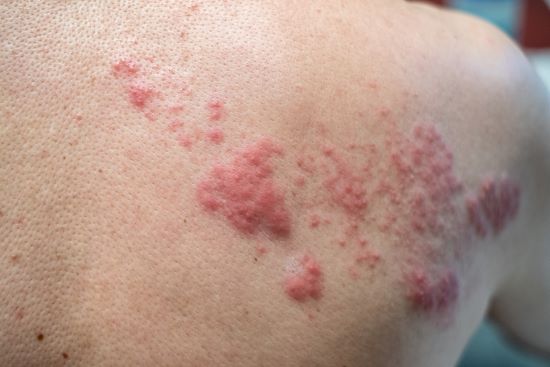About shingles
Shingles is caused by Varicella zoster virus.
Shingles happens only in people who’ve previously had chickenpox.
When children have had chickenpox, Varicella zoster virus ‘sleeps’ in their nerve cells. The virus can ‘wake up’ and cause shingles in children who:
- are run down after illness
- have an underlying condition affecting their immune systems
- are taking medicine affecting their immune systems.
You can’t ‘catch’ shingles. But if your child hasn’t been immunised against chickenpox or hasn’t had chickenpox before, they can catch chickenpox from someone with shingles.
Shingles rarely affects children under 3 years of age. It’s rare in children and more common in adults.
Shingles symptoms
Shingles might start with pain or burning on a patch of skin, followed by a rash of small lumps. The rash might look purple, brown or grey on dark skin or red on light skin. The lumps form fluid-filled blisters. The blisters cluster together on a single patch of skin. New lumps form over the first few days, and then the blisters crust over.
The rash occurs on the upper body more often than on the face, legs or arms.
Sometimes shingles can affect the outside lining of the eye. If this happens, the white of the eye might go red. The eye might also be sore, and there might be tiny ulcers around the eye.
In children, the shingles rash usually isn’t as painful or itchy as in adults, and it heals completely within 2 weeks. In rare cases, children might have ongoing pain after the rash has gone.
Children usually don’t feel ill or have a fever.

Medical help: when to get it for children with shingles
You should take your child to your GP if your child’s rash:
- is on their face or around their eyes
- looks infected
- doesn’t clear up in 10-14 days.
Also see the GP if your child:
- gets the rash and suffers from a chronic health condition
- gets the rash and is taking medicines that affect their immune system
- has a fever or is unwell
- has a rash and you’re not sure whether it’s shingles.
You know your child best. If your child seems unwell, seek medical attention.
Shingles treatment
If your child has shingles, you can treat their symptoms to help them feel more comfortable.
Paracetamol or ibuprofen might help relieve mild pain. Avoid applying creams or lotions to the rash. If your child has scratched the rash and broken the skin, make sure to clean the area well.
If shingles is diagnosed within 72 hours of the rash starting, your GP might be able to prescribe an antiviral medicine. This can reduce pain associated with shingles.
Don’t give aspirin to children under 12 years unless it’s prescribed by a doctor. Aspirin can increase the risk of Reye’s syndrome, a rare but potentially deadly condition. If you’re giving your child any over-the-counter medicines, check with your pharmacist or doctor to make sure these have no aspirin.
Prevention of shingles
As part of the Australian National Immunisation Program (NIP), your child will get free immunisation against Varicella zoster virus when they’re 18 months old.
If your child has shingles, try to make sure that everybody who comes into contact with them has been immunised against chickenpox or has had chickenpox before.
Newborn babies and children with low immunity should avoid contact with anyone with shingles.
If you have shingles and are caring for a child, make sure to keep your rash covered to reduce the risk of passing on the virus.
If your child’s shingles rash is completely covered, they can go to school. Your child shouldn’t swim or play contact sports for 7 days after the rash appears. If the rash can’t be covered, your child should stay at home until the rash has scabbed over.